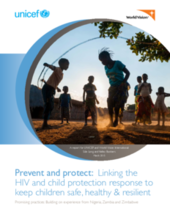This report from UNICEF and World Vision documents country level approaches that respond to HIV and child protection challenges facing children and adolescents by linking both those responses.
The report provides practical examples from Nigeria, Zambia and Zimbabwe of how both government and civil society organisations are linking child protection interventions to HIV prevention, treatment, care and support, resulting in improved impacts on both HIV outcomes and decrease in child abuse, violence, exploitation and neglect.
The report describes a wide-ranging set of approaches including community-based projects as well as government coordination mechanisms, working in both HIV and child protection. The examples include programmes where HIV-positive adolescents and young people are training health workers across the country, the use of social media and ICT technologies to identify and refer cases of HIV, abuse, violence or neglect and mechanisms that provide critical referrals between the social welfare and health sectors.
Key findings of the report include:
· Neglect, abuse and violence in the home appear to severely limit the ability of children living with HIV to access appropriate HIV testing, treatment and ongoing support;
· Children affected by HIV appear to experience high rates of HIV-related stigma, which manifests as neglect, violence or abuse, from family, peers, community and service providers.
· Children who are vulnerable to or victims of abuse, violence, neglect and exploitation or who are in especially vulnerable situations such as alternative family care, residential care or on the streets, often present an increased risk of HIV.
The report suggests that with minimal adjustments to existing practice, it is possible to make a significant difference in the lives of children living with or highly vulnerable to HIV. These children are often those that the child protection system is most trying to reach and support; thus coordination is critical. The positive examples highlighted in the report have all:
· Actively and consistently ensured that key actors meet and work together at the local level;
· Talked openly about both HIV and child protection issues and their relationship to one another;
· Involved HIV-affected communities, especially children, adolescents and caregivers, in the design and delivery of services.
The intention is that the report will stimulate policymakers and programmers to consider interventions that link across sectors, and to support implementation and evaluation of these interventions.

